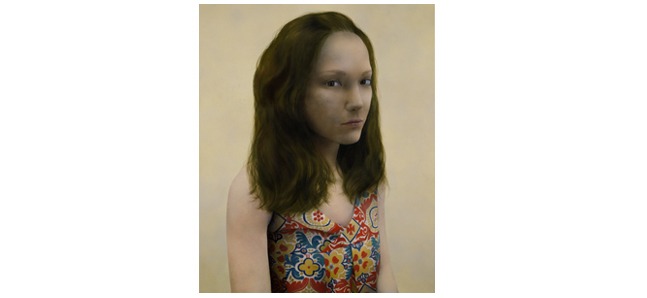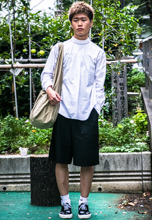
Satoko Nachi
Posted: Mon Feb 08 2010
Hirokazu Koreeda’s film ‘Nobody Knows’ and the Dardenne brothers’ ‘L’enfant’, both feature characters with an unwavering will to live. With their solemn and peaceful eyes, artist Satoko Nachi’s portraits display a similar sense of strength. Hidden in her own self-portrait is a determination for rebirth via death. Time Out Tokyo met Satoko Nachi at her solo exhibition ‘Confessions’ which runs until Sat Feb 13 at the Tomio Koyama Gallery in Kiyosumi Shirakawa.
There are many portraits in this exhibition; are the subjects in your paintings friends of yours?
SN: The subject in the painting titled ‘S’ is the only fictitious one. In all the other works, the subjects are either my friends or I.
Your paintings are very detailed; however, it doesn’t seem important for you to portray your subjects true to life.
SN: Rather than accurately portraying their physical appearance, I want to show their inner character: not the ‘realness’ of a photograph, but rather she who can only be portrayed within a picture. I select my models based on their strength of character and sense of conviction. When you are 16 or 17 and a high school student, you feel invincible. I’m 27 and it’s not like that anymore. I wanted to portray the strength of women similar in age to me. When I have coffee with my friends, I listen to them grappling with problems and asking for advice. However, when they make a decision, I think, ‘This person is amazing!’ and this makes me want to draw them.
You mean ‘girl’s talk’. [Laughs]
SN: Yep! [Laughs] I want my paintings to show real people, not objects. I want to show the person existing within, usually unseen by the outside world. This is what I am trying to do in this exhibition. Confessions… of truth, of love… this is why I chose ‘Confessions’ as this exhibition’s title.
In the smaller room, the paintings are all of your friends?
SN: It’s like the viewer is being looked at from all three sides. It’s meant to be a confessional room.
Some paintings certainly look religious. But the way you depict yourself in your self-portrait is different. When you draw yourself, are you trying to depict your own inner strength?
SN: I’m not sure whether it’s strength, but it takes over about 99% of my life when I am doing a self-portrait. I guess this is the feeling that you see. When I painted myself in ‘Komori-uta’ (Lullaby), I was feeling intensely negative. I had a kind of meltdown and the painting became much bigger and turned into the dark painting that it is now. It says, ‘I don’t need to be bright anymore’. [Laughs]
The woman in that picture is really falling. [Laughs] Falling, but static, so it doesn’t feel completely tragic. Somehow it feels that you are trying to bury yourself.
SN: That’s probably true. I am falling to my death, but it’s a peaceful sleep-like death. It’s sublimely negative, but as I was painting ‘Komori-uta’ I thought to myself, ‘Oh, I’m dying, I’m falling’ and gradually felt more peaceful.
Are many of your self-portraits dark?
SN: Many are. Seeing I only paint about personal things. [Laughs]
But when you paint your friends, your depictions are more positive?
SN: I suppose so. Although they look serious, I am trying to portray my friends’ strength so I don’t intend for them to be dark in nature.
Discussing whether your self-portraits are positive or negative, it seems that both of these forces exist concurrently. Your self-portrait conveys a feeling of strength, of bringing yourself back to life through death, which can be interpreted positively. What about your photos?
SN: In this exhibition, ‘Bad Ending’ shows me sitting on top of a building immediately after something sad has happened. I’m saying, ‘I want to be dead. Anything and everything hurts me.’ I am on top of that house because that is where it the bad ending happened. [Laughs]
Your previous photography consists of self-portraits. The photographs in this exhibition seem somewhat different, more conceptual and staged. But according to you there is no difference?
SN: They’re not that different. In ‘Bad Ending’ I was really crying. When an idea comes to me I am like, ‘Right. Let’s do it.’ In a painting, the composition seems to be well thought out, but photographs really feel like drawing to me. When an idea comes you click the button and there it is, it seems so simple.
By the way, why don’t you paint pictures of males?
SN: I am painting my first picture of a male for the Vision of Contemporary Art VOCA exhibition.
Your first?
SN: Yes, a boy wearing his school uniform. I painted a ghost possessing me. [Laughs] At the time, I’d been thinking to myself, ‘Why is it that even though I have someone whom I really love now, in several years time I’ll be in love with someone else?’ I thought about it and came to the conclusion that this ghost won’t allow himself to be forgotten. He will move onto another man and make me fall in love with him. The boy in the painting is this ghost. This painting is really something. Once it is finished I won’t be able stop looking at him and I’ll say, ‘You’re a handsome boy.’ Even men who see it will feel something. Perhaps they’ll even fall for him!
That is something to look forward to. You are based in Aichi prefecture. Are you coming to Tokyo for VOCA?
SN: Yes. I usually come to Tokyo once or twice a year with friends to see exhibitions. I really love the Mori Art Museum. It is so high up. I usually go there late. When I look out and see the Tokyo Tower at night I think to myself, ‘You can do it’ and then I go home [Laughs].
So you make a wish to the Tokyo sky. [Laughs] Lastly, what are you going to paint next?
SN: I want to paint more pictures of my friends and the strength possessed by so many women. I want to line up all the paintings and make men tremble in fear. [Laughs]
About the artist
Satoko Nachi was born in Tokyo in 1982. She graduated from School of Art, Nagoya University of Arts and currently lives and works in Aichi prefecture. In 2008, she took part in ‘project N 32’ at Tokyo Opera City Art Gallery. In 2009 she gained much attention at the Kumamoto, Contemporary Art Museum exhibition titled ‘Flowers and Landscape Claude Monet and Young Japanese Artists: Shinji Ohmaki, Mika Ninagawa, and Satoko Nachi’. She will be exhibiting her work at the VOCA exhibition in 2010.
Satoko Nachi ‘Confession’
Location: Tomio Koyama Gallery
Address: 7F Maruhachi Soko Bldg, 1-3-2 Kiyosumi, Koto, Tokyo
Telephone: (03)3642 4090
When: Until Sat Feb 13
Open: 12noon-7pm closed on Sun, Mon and Nat. holidays
Website: www.tomiokoyamagallery.com
Related articles
・Noguchi’s geometric zoo
Time Out Café & Diner hosts young artist’s solo menagerie show
・A choir of complaints in Tokyo
Duo bring relief with a choir of complaints for MAM Project 10
・Nick Walker paints Tokyo red
Bristol artist gets out his paints and tells Time Out Tokyo about his art
Tags:
Tweets
- About Us |
- Work for Time Out |
- Send us info |
- Advertising |
- Mobile edition |
- Terms & Conditions |
- Privacy policy |
- Contact Us
Copyright © 2014 Time Out Tokyo











Add your comment